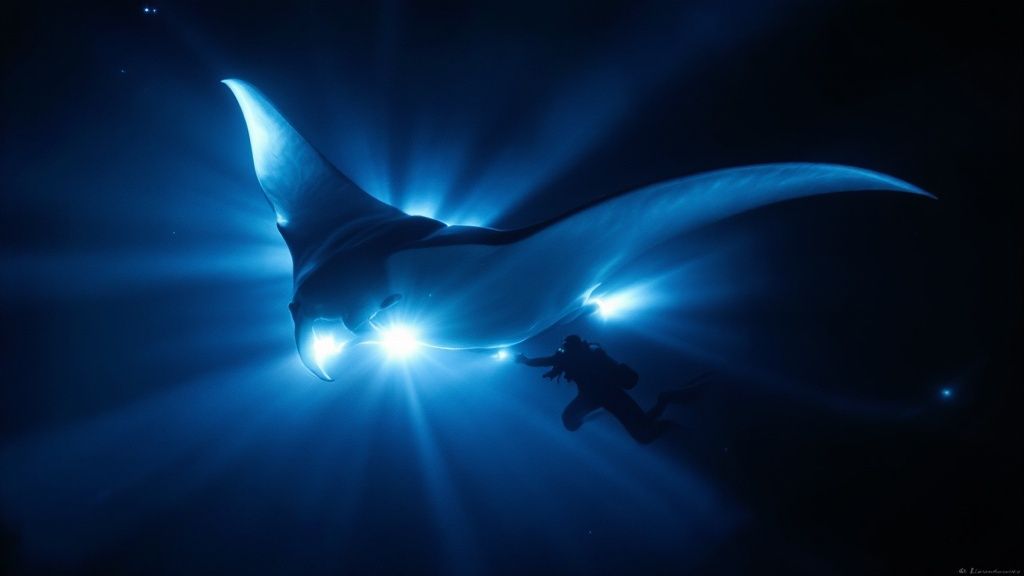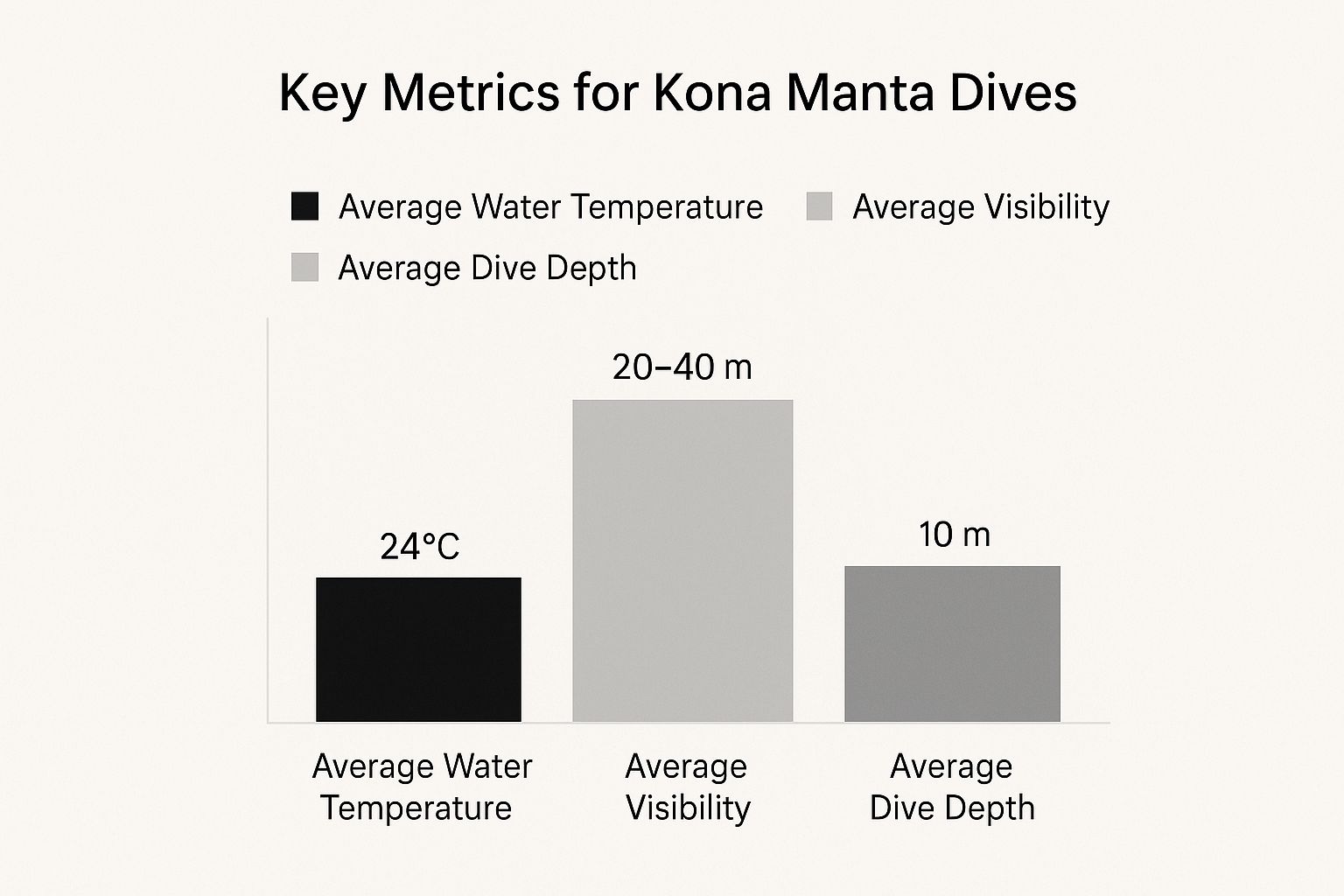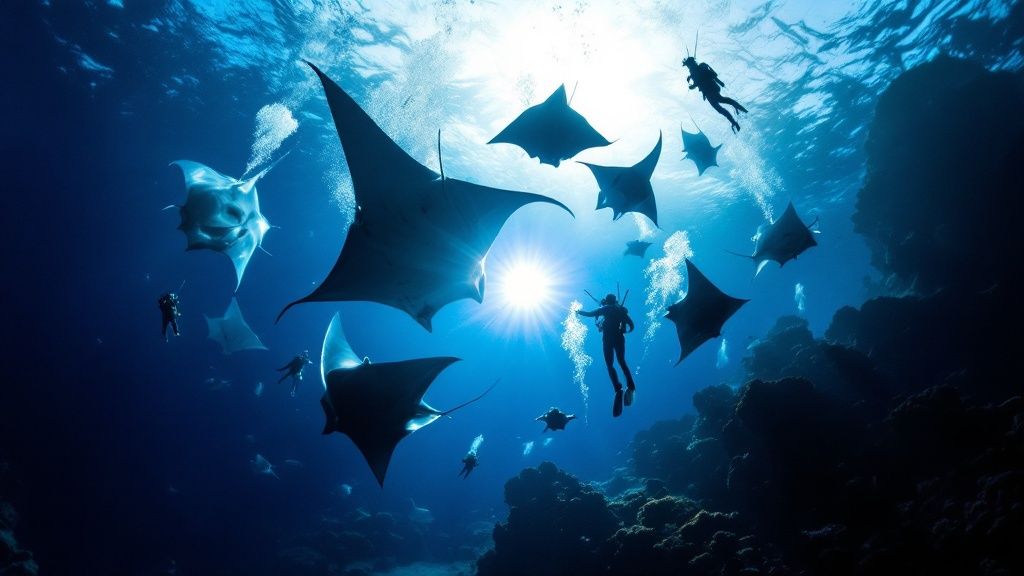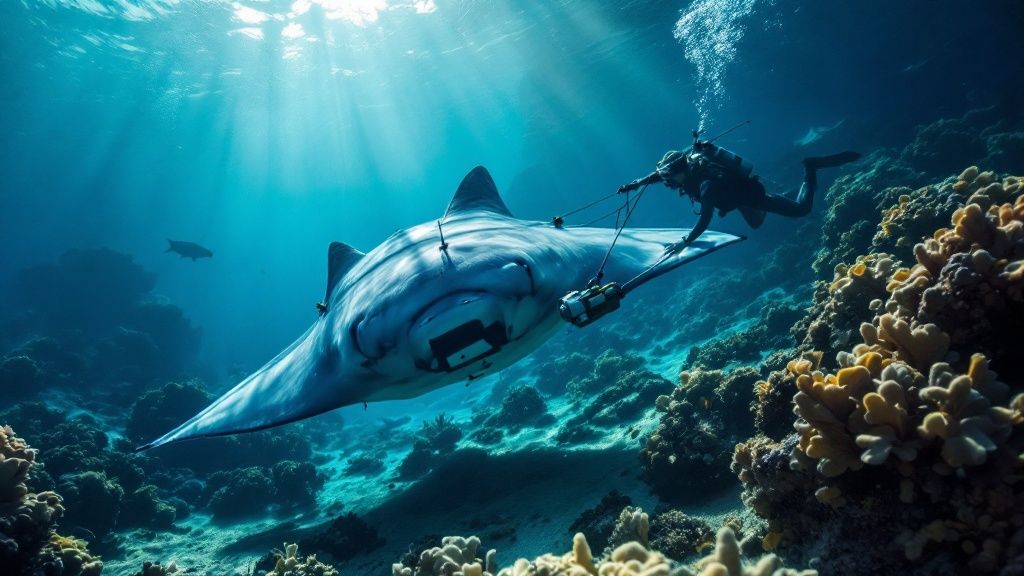The Magic of Manta Dive Kona: Why It's World-Famous
Kona, Hawaii, is more than just a beautiful island. It's a global hotspot for manta ray night dives. These incredible encounters are possible due to a unique combination of environmental factors. The island's volcanic topography, formed by ancient lava flows, creates slopes and canyons. These geological features channel nutrient-rich currents, which are crucial for the growth of plankton, the manta ray's main food source. This abundance of food attracts these gentle giants night after night. This reliable food source makes Kona a unique and virtually guaranteed location to encounter manta rays, appealing to both divers and researchers. Curious about what a manta ray night dive entails? Check out this resource: What is a manta ray night dive?
Kona: A Manta Ray Paradise
The Kona Coast offers exceptional viewing opportunities, particularly at designated sites like Manta Village and Manta Heaven. The sighting success rates for manta ray night dives on the Kona Coast are remarkably high, consistently reported between 85% and 90%. These dives usually take place at depths of 30 to 40 feet, allowing for dive times of 45 to 60 minutes. This relatively shallow depth, combined with underwater lights, provides an incredible view of these majestic creatures, some with wingspans exceeding 12 feet. With a local manta ray population estimated at over 450 individuals, Kona represents one of the largest known aggregations in the world. This makes the Kona manta dive a truly special and successful example of eco-tourism, attracting thousands of divers annually. For more detailed statistics, see the Jack's Diving Locker Manta Report.
The "Campfire" Effect: A Feast for the Senses
The underwater volcanic formations also enhance the overall experience. The sloping seabed is perfect for the "campfire" technique employed by dive operators. Divers gather around specialized lights placed on the ocean floor. These lights attract plankton, creating a luminous feast that draws in the mantas. The result is a stunning display of graceful barrel rolls and captivating feeding formations just below the surface. This predictable behavior makes Kona an ideal diving location for all skill levels, from beginners to experienced professionals.
Conservation and Accessibility
Kona stands out because of the accessibility of these encounters. Through various dive and snorkel options, both experienced divers and those new to the sport can witness this marine marvel. The combination of nutrient-rich waters, unique volcanic formations, and responsible tour operators ensures an unforgettable experience for visitors worldwide. This focus on responsible tourism contributes to the area's success, carefully balancing accessibility with the protection of this delicate ecosystem. Learn more about the reasons to experience a manta ray dive in Kona: Why should you go on a manta ray dive in Kona?

The Science Behind Kona's Magnificent Manta Encounters
The nightly ballet of manta rays in Kona is a captivating spectacle, a testament to the intricate ecological relationships of the Hawaiian waters. These gentle giants aren't just drawn to the lights by chance. Their presence is orchestrated by a precise combination of factors that makes Kona a unique manta ray dive destination.
The Plankton Connection: Fueling the Feast
The key ingredient in this nightly gathering is plankton. These microscopic organisms form the foundation of the manta ray diet. Kona's volcanic slopes, combined with nutrient-rich currents, create a thriving environment for plankton blooms. This consistent food source is the main attraction, bringing the mantas back night after night. It’s like a reliable restaurant always serving their favorite meal. This predictable abundance allows the mantas to flourish and provides a reliable experience for Manta Dive Kona enthusiasts.
Behavioral Adaptations: Mastering the Night
Mantas have developed specific behaviors to maximize their feeding efficiency in these plankton-rich waters. Their graceful barrel rolls and chain-feeding formations aren't just visually stunning; they're strategic maneuvers. These movements create swirling currents, concentrating the plankton and making it easier for the mantas to filter vast quantities of water and consume their microscopic meals. Their cephalic fins, located on either side of their mouths, act like natural scoops, funneling plankton directly into their mouths.
Citizen Science and Identification: Unlocking Manta Mysteries
Beyond understanding their feeding behaviors, scientists are also working to track individual mantas. Each manta has a unique pattern of spots on its belly, much like a human fingerprint. Through citizen science initiatives, divers and snorkelers contribute to a growing database of these unique markings. Between 2009 and 2014, dedicated teams meticulously documented manta ray sightings along the Kona Coast. This compiled invaluable data on individual mantas, their behavior, and their movements. This data provides critical insights into manta ray population dynamics, migration patterns, and even social interactions. Learn more about manta ray statistics. This collaboration between scientists and the public provides crucial data that enhances both conservation efforts and the overall manta dive Kona experience.
Conservation Through Understanding
This deep understanding of manta ray biology and behavior is crucial for developing effective conservation strategies. By understanding where mantas congregate, how they feed, and which environmental factors influence their movements, researchers and conservationists can better protect these magnificent creatures and their vital habitat. This knowledge continually informs best practices for manta dive Kona operators, ensuring that these incredible encounters remain sustainable for future generations.
Planning Your Perfect Manta Dive Kona Experience
Transform your Hawaiian vacation into an unforgettable adventure with a meticulously planned manta ray encounter. This guide will walk you through the key decisions, ensuring a truly magical experience. From choosing between snorkeling and diving to selecting the best time of year, we'll cover everything you need to know.
Choosing Your Adventure: Snorkeling vs. Diving
The first step is deciding how you want to interact with these gentle giants. Snorkeling offers a surface-level perspective, perfect for all ages and experience levels. If you're comfortable in the water and prefer a more relaxed observation, this is an excellent choice.
Diving, however, provides a completely different experience. Certified divers can descend to the ocean floor for a remarkably close and personal encounter, witnessing the mantas feeding right before their eyes. This immersive perspective is truly unforgettable, though certification is required.
Timing is Everything: Optimal Conditions for Manta Encounters
Manta rays grace Kona's waters year-round, but certain periods offer more favorable viewing conditions. The dry season, spanning from April to October, typically boasts calmer seas and heightened visibility. This makes it much easier to observe the mantas' graceful movements.
That being said, even the winter months (November to March) can offer spectacular encounters.
The infographic below provides a snapshot of the average conditions for Kona manta dives:

The infographic reveals an average water temperature of a comfortable 24°C (75°F), with visibility often ranging from 20–40 meters (65–130 feet). The average dive depth is a manageable 10 meters (33 feet), making these dives accessible to a variety of skill levels. This combination of factors creates an ideal environment for unforgettable manta ray viewing.
Selecting Your Tour Operator: Prioritizing Safety and Sustainability
Choosing the right tour operator is paramount. Look for businesses demonstrably committed to sustainable tourism practices, like adherence to guidelines set by organizations such as Project AWARE. Ask about group sizes, guide experience, and their approach to minimizing impact on the manta rays' natural habitat. Smaller groups and seasoned guides often offer a more personalized and responsible experience.
To help you choose the best tour operator for your needs, we've compiled the following comparison:
Manta Dive Kona Tour Operators Comparison
A comprehensive comparison of the top manta ray dive tour operators in Kona, including their offerings, prices, group sizes, and special features.
| Tour Operator | Price Range | Group Size | Dive/Snorkel Options | Special Features | Departure Location |
|---|---|---|---|---|---|
| Kona Honu Divers | $150 – $200 | 6-8 | Both | Small groups, experienced guides, focus on sustainability | Honokohau Harbor |
| Big Island Divers | $120 – $180 | 8-10 | Both | Photography packages, night dives | Keauhou Bay |
| Manta Ray Dives of Hawaii | $140 – $190 | 10-12 | Snorkel only | Family-friendly, sunset tours | Kailua-Kona Pier |
| Jack's Diving Locker | $160 – $220 | 6-8 | Dive only | Advanced dive options, equipment rentals | Honokohau Harbor |
This table highlights some of the popular tour operators in Kona, offering a range of options for different budgets and preferences. Remember to research each operator carefully and choose one that aligns with your needs and values.
Preparing for Your Dive: Gear and Personal Readiness
Adequate preparation is key to a comfortable and enjoyable dive. While most operators provide basic snorkel gear, having your own mask and fins can significantly enhance your comfort. A wetsuit or thermal protection is also recommended, as the water can become cooler at night. Remember to bring a towel and dry clothes for afterward.
Beyond gear, familiarize yourself with basic snorkeling or diving techniques, depending on your chosen activity. Don't hesitate to communicate any concerns to your guide, who can offer support and assistance. Finally, while manta ray sightings are frequent in Kona, keep in mind that they are wild creatures. Embrace the unpredictable nature of these encounters and enjoy the magic of sharing their underwater world.
What Happens During Your Manta Dive Kona Adventure
Embark on a manta dive Kona adventure, and prepare to be mesmerized by the underwater world. The journey begins with an exciting boat ride to one of Kona's famed manta ray viewing spots. Along the way, expert guides, often marine biologists or experienced divers, share insights into Kona's unique ecosystem and its importance to manta rays. You can learn more about what to expect on a manta ray dive in Kona by visiting Kona Honu Divers. This pre-dive briefing helps build excitement for the main event.
Preparing for the Encounter: Lights, Camera, Action!
Once at the dive site, the real preparation begins. Divers and snorkelers enter the water and find their designated positions. Divers typically descend to the ocean floor, forming a semi-circle around specialized lights placed on the seabed. These lights attract plankton, creating an illuminated feast for the mantas, much like a campfire attracts people. Snorkelers, on the other hand, hold onto a floating platform with downward-pointing lights, providing a surface view of the spectacular display. These lighting arrangements minimize disturbance to the manta rays' natural feeding patterns while maximizing visibility.
The Manta Ballet: A Symphony of Grace
As the lights illuminate the water, the magic begins. Attracted by the plankton, the manta rays arrive. These gentle giants, with wingspans sometimes over 12 feet, glide effortlessly through the water, performing graceful barrel rolls and captivating feeding formations. The sight is truly breathtaking, like a squadron of underwater acrobats performing a synchronized routine. This mesmerizing display is often called the "manta ballet," a truly unforgettable experience. Remember to stay calm and observe respectfully, allowing these majestic creatures to display their natural behaviors undisturbed.
An Unforgettable Experience: More Than Just a Dive
The manta ray night dive is carefully orchestrated, prioritizing both the human experience and the well-being of the mantas. The Kona Coast manta ray night dives attract approximately 80,000 snorkelers and divers each year, making it one of the most popular manta ray interaction sites globally. Learn more about manta ray tourism. This high demand highlights the unique nature of this experience. It's an opportunity to witness the magic of the ocean, connect with nature, and contribute to the ongoing conservation efforts that protect these gentle giants and their habitat. The memory of the manta ballet will stay with you long after you resurface.

Best Manta Dive Kona Sites: Where Magic Happens Nightly
The Kona coast of Hawaii offers an incredible opportunity to witness the magic of manta rays. These gentle giants perform a nightly ballet, drawing divers and snorkelers from around the globe. But not all dive sites are created equal. Some locations, due to their unique characteristics, provide more consistent and spectacular manta ray encounters. Let's explore some of the best manta dive Kona sites and what makes them special, starting with the renowned Kona's Manta Ballet.
Manta Village: The Original Hotspot
Often considered the birthplace of the manta ray night dive, Manta Village, nestled in Keauhou Bay, offers an ideal setting for both beginners and experienced divers. The shallow, sandy bottom, typically between 10-15 feet deep, enhances visibility, making it perfect for observing the mesmerizing manta ballet. Here, the "campfire" technique is employed. Divers kneel around lights placed on the ocean floor. These lights attract plankton, the manta rays' primary food source, creating an unforgettable feeding frenzy just a few feet away.
Manta Heaven: A Cove of Graceful Giants
Just north of Kona International Airport lies Manta Heaven, also known as Garden Eel Cove. This site is known for attracting larger groups of manta rays, sometimes numbering 8-12 individuals. The deeper waters, around 20-30 feet, and occasionally stronger currents make this spot more suitable for intermediate and experienced divers. While sightings might not be as predictable as at Manta Village, the chance to see multiple mantas performing their graceful underwater dance is a breathtaking experience.
Beyond the Famous Two: Hidden Gems
While Manta Village and Manta Heaven are justifiably famous, the Kona Coast offers other, lesser-known dive sites. These hidden gems, often favored by local divers, provide a more intimate experience with potentially fewer crowds. Sightings may be less predictable, but the allure of a more private encounter with these majestic creatures, combined with unique underwater topography and diverse marine life, is a strong draw.
Choosing Your Perfect Spot: A Comparison
To help you choose the best manta dive Kona site for your experience level and preferences, the following table compares the key features of each location:
To help you decide where to dive, the following table compares Kona's main manta ray dive sites:
Kona Manta Ray Dive Sites Comparison
A detailed comparison of the main manta ray dive sites in Kona, including location characteristics, average manta sightings, and best times to visit
| Dive Site | Location | Average # of Mantas | Depth | Experience Level | Best Time to Visit | Special Features |
|---|---|---|---|---|---|---|
| Manta Village | Keauhou Bay | 4-6 | Shallow (10-15ft) | Beginner – Experienced | Year-round, best April-October | "Campfire" feeding, high sighting consistency |
| Manta Heaven (Garden Eel Cove) | North of Kona Airport | 8-12 | Deeper (20-30ft) | Intermediate – Experienced | Year-round | Larger aggregations, diverse marine life |
| Other Kona Coast Sites | Various | Varies | Varies | Varies | Varies | Secluded experiences, unique topography |
As you can see, each location offers a unique experience. Manta Village provides consistent sightings in a shallow setting, ideal for beginners. Manta Heaven, while deeper and requiring more experience, offers the potential to see larger groups of mantas. And for those seeking a more secluded encounter, the lesser-known sites provide a unique adventure. No matter which location you choose, Kona's manta ray dives offer an unforgettable encounter with these gentle giants. These sites represent a delicate balance between accessibility and conservation, ensuring that future generations can also witness this underwater magic.
Capturing the Magic: Photography Tips for Manta Dive Kona
A manta dive in Kona, Hawaii is an unforgettable experience. Capturing those memories with stunning photography makes it even more special. This unique night dive presents some photographic challenges, but with the right techniques, you can transform your encounter into breathtaking images.

Mastering Low-Light Conditions: Camera Settings For Success
Night diving presents unique low-light challenges. To capture the beauty of the manta rays against the dark backdrop, you'll need to adjust your camera settings. Start by setting your ISO to a higher level, typically between 800 and 1600, to increase light sensitivity. Be mindful of excessive noise at very high ISO levels. A wide aperture, indicated by a lower f-stop number (such as f/2.8), allows more light into your camera. This enables faster shutter speeds to freeze the manta rays' motion. Experiment to find the best balance between brightness and clarity.
Composition and Framing: Showcasing The Manta's Majesty
Manta rays are magnificent creatures, and your photos should reflect their size and grace. Try using the rule of thirds to create dynamic and visually appealing compositions. Focus on capturing the manta's entire wingspan to emphasize its grandeur.
Don't be afraid to experiment with different angles and perspectives. Shooting from below can create dramatic silhouettes against the illuminated water. Try to capture the manta's eye, adding a powerful connection and a sense of character to your images.
Respectful Positioning: Getting The Shot Without Interference
Capturing great photos is exciting, but it's crucial to prioritize the manta rays' well-being. Maintain a respectful distance and avoid using flash, which can disorient and stress these gentle giants. Position yourself carefully, avoiding interference with their natural feeding behaviors.
If you're looking for other Hawaiian adventures after your dive, consider visiting other islands. There are other attractions worth visiting, such as those in: Honolulu. Remember, patience is key. The mantas will naturally move through the illuminated area, offering ample photo opportunities.
Equipment Recommendations: From Smartphones To Professional Setups
From basic smartphone housings to high-end underwater camera systems, equipment options exist for every budget. Even with a simple setup, you can capture amazing manta ray photos. If using a smartphone, invest in a quality waterproof housing and explore external lighting options. For dedicated underwater cameras, wide-angle lenses are recommended to capture the full scope of the manta's size. Whatever your equipment, practice using it before your dive.
Contributing to Citizen Science: Your Photos Make A Difference
Your manta ray photos can contribute to valuable citizen science. Many research organizations use photographs to identify and track individual mantas based on their unique belly patterns. Sharing your images helps monitor population trends and contributes to conservation. This turns your hobby into a meaningful way to protect these magnificent creatures.
Beyond the Dive: Supporting Manta Conservation in Hawaii
Your manta ray dive in Kona can be much more than an unforgettable experience; it can be a contribution to a larger cause. The tourism choices you make have a direct impact on manta ray protection and the overall health of their population. By understanding the current state of Hawaii's manta rays and the difficulties they face, you can make a real difference.
Choosing Responsible Operators: A Vote for Conservation
One of the most impactful ways you can support manta ray conservation is by carefully selecting your tour operator. Look for companies that prioritize animal welfare and actively support research initiatives, rather than focusing solely on profits. For instance, ask about their commitment to sustainable tourism guidelines and whether they contribute to local conservation groups. Supporting responsible operators strengthens ethical practices within the industry and ensures the long-term well-being of the manta ray population. You might be interested in: Why should you go on a manta ray dive in Kona?
Citizen Science: Become a Manta Ray Advocate
Beyond choosing responsible tour operators, you can contribute to manta ray conservation in other ways. Citizen science offers valuable opportunities for anyone to participate in research. By taking photos of manta rays and submitting them to identification databases, you can assist in tracking individual animals and contribute to long-term monitoring projects. This data is crucial for understanding population trends and developing effective conservation plans.
Supporting Local Organizations: Amplifying Your Impact
Consider supporting local conservation organizations dedicated to protecting manta rays and their environment. These groups conduct critical research, lobby for protective legislation, and educate the public about the significance of manta ray conservation. Even small donations can significantly impact their work to protect these magnificent creatures.
From Tourist to Steward: A Deeper Connection
By making informed choices and actively participating in conservation, your manta dive Kona experience becomes more than just tourism; it becomes a meaningful contribution. This not only benefits the manta rays but also deepens your connection with these amazing animals. You become a steward of the ocean, playing an active role in its protection and ensuring its health for generations to come.
Ready to experience the wonder of a manta ray dive with a company committed to conservation? Book your unforgettable adventure with Kona Honu Divers today!
